There’s a joke going around that the S&P 500 isn’t the S&P 500 anymore. It’s now the “S&P 5.”
(Well, last Thursday, the five got punched in the face. With no meaningful dividends to cushion the fall, it was all “red on the screen.”)
I’m talking about the five mostly dividend-less stocks that have been driving the rebound since March—tech darlings and low/no yield wonders Apple (AAPL), Microsoft (MSFT), Amazon.com (AMZN), Alphabet (GOOGL) and Facebook (FB).
Rebound Leaves Dividend Investors Behind
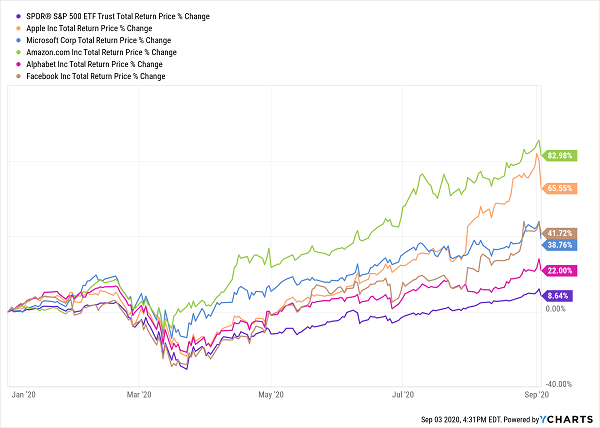
If you’re not holding these big names, or if you only have a small position, well, the joke’s been on you (with the exception of last Thursday, of course!). Look at the S&P 500’s performance this year when you weigh its sectors equally. (And bear in mind that many sectors, like energy, are in worse shape.)
The “Gain” Most Folks See (if They’re Lucky)
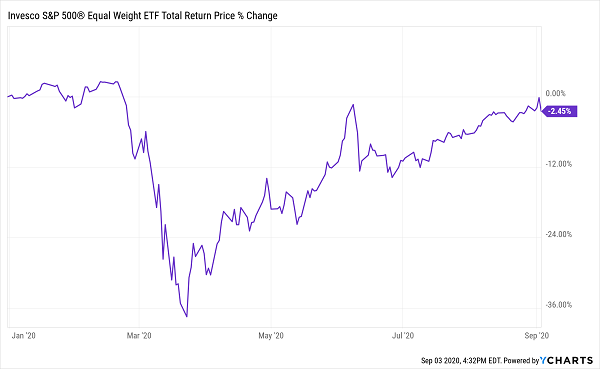
Sure, a 2.5% loss is a lot better than the 36% drop we faced in March, but it’s still well behind the S&P 500’s 8.6% year-to-date gain.
Now, with the S&P 500 trading at a nosebleed 27-times forward earnings, it’s fair to wonder how you’ll ever get your underwater positions back to green. Or, if you’re one of the folks who sold in March, whether you’ve missed the boat entirely.
Well, I’ve got good news for you: it’s not too late. I’ll show you a simple way to prime your portfolio for double-digit upside and 8% dividends shortly. First, though, I want to talk about one mistake you must avoid if you want to make any losses you’re sitting on now permanent.
Resist the Temptation to Play the Calendar
I normally write about the “sell in May and go away” phenomenon in the spring, but we need to talk about it now because 2020 is pointing out just how damaging this investing “wisdom” can be.
“Sell in May,” of course, refers to the notion that stocks tend to go nowhere (or retreat) from May through October and rise from November through April. The data does back that up (which is why this strategy is so tempting): a study by professors Ben Jacobsen and Cherry Yi Zhang found that stock returns were indeed 4% higher, on average, during fall/winter than in spring/summer.
Let’s stop here for a moment, because if you own the high-yield stocks and funds in my Contrarian Income Report service’s portfolio, you’re getting 7.9% (going by the portfolio’s current yield) in dividends alone, double the average 4% seasonal gain.
That’s enough to pay you about $40,000 in income on a $500K investment. With income like that, you could live on dividends alone in many parts of America. So right off the bat, you can ignore “sell in May” and simply keep collecting your dividends!
That aside, every so often the “sell in May” strategy takes a nasty turn that can do a lot of damage to your portfolio. And you probably won’t be surprised to hear that 2020 is one of those times.
Let’s say you bought the benchmark SPDR S&P 500 ETF Trust (SPY) on November 1, 2019. You then “went away” and sold on May 1, 2020. For your trouble, you got a 7.6% loss:
“Sell in May” Costs You Once …
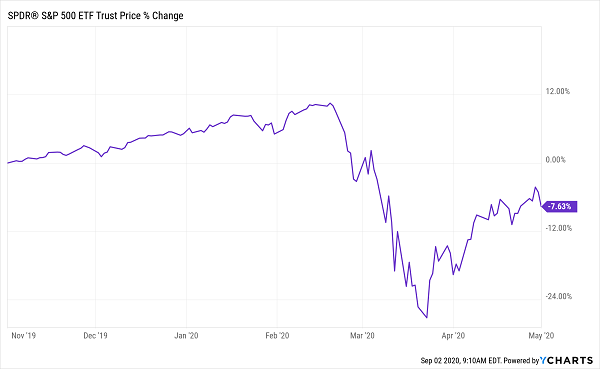
That’s the opposite of what’s supposed to happen! Worse, you’d have been on the sidelines while the S&P 500 decided to not take the summer off—and soared 20.6%:
… And Again
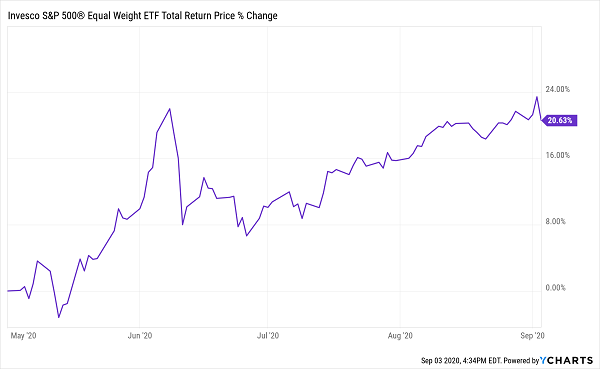
The pain hits home when you put this in dollars and cents. Let’s say we’re talking about a $300,000 portfolio invested in an S&P 500 index fund here. Its value would have been sliced to $277,200 in the six months from November to May. Then you would have locked in that loss and missed out on a $57,190 total return!
This is why you must avoid slogans like “sell in May and go away” and instead build a portfolio that pays a dividend stream you can live on—without counting on the market’s day-to-day gyrations.
CEFs Give You 3 Ways to Win
A great place to find that kind of safe, high income is in high-yield closed-end funds (CEFs). The key thing to remember about CEFs is they have three ways to pay us:
- Their outsized dividends: There are about 500 of these steady income plays out there, yielding 7% on average, now.
- A closing “discount” window: Unlike ETFs and mutual funds, CEFs often trade for less than net asset value (NAV, or the per-share value of their underlying portfolios). So by purchasing a fund at a big discount, we can cash in as the discount vanishes, pulling the share price up with it. (It’s literally like having the fund’s price on a string.) And …
- A jump in (NAV), as their portfolios increase in value.
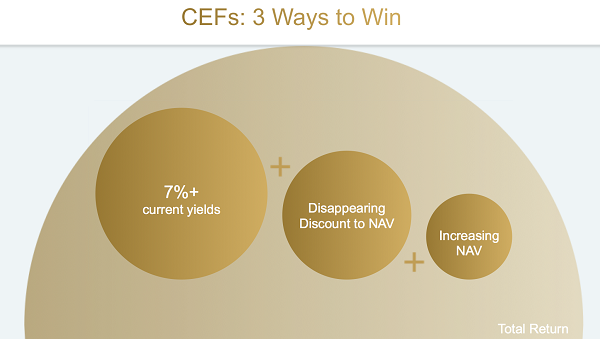
Source: Contrarian Income Report Q3 subscriber webcast
To see how these three steps play out in your favor, consider the DoubleLine Income Solutions Fund (DSL), a long-time Contrarian Income Report holding. The “Bond God” himself, Jeffrey Gundlach, runs DSL; he’s known for his history of accurate contrarian calls, including his warning of a building subprime-mortgage crisis in 2007.
The first way DSL pays us is through its dividend, which yields 11% as I write this and is paid monthly. So right away, you’re outperforming the market’s historical average in dividends alone.
Now let’s talk about the discount and the NAV increase, which combined to fuel an outsized gain for folks who bought the last time the fund’s discount got well out of step with its market price (prior to the spring 2020 selloff, that is).
That would be back on December 21, 2018, when DSL traded at a totally unusual 14% discount. Buyers who jumped in then saw that discount flip to a 5.3% premium over the next 11 months.
That disappearing discount helped catapult the fund to nearly triple the return of the corporate-bond benchmark SPDR Bloomberg Barclays High-Yield Bond ETF (JNK). DSL even beat the S&P 500—something income plays like this simply aren’t supposed to do!
Discount Disappears, DSL Soars

And these returns include dividends—so a third of DSL’s 33% return in that 11-month period was in cash!
So where do we stand with DSL now?
The fund trades at just a 1% discount, so its “discount afterburner” is pretty much spent. As a result, I don’t recommend new buying here, so I’m recommending that Contrarian Income Report members hold their positions—and keep collecting their rich dividends. If you don’t own DSL, do put it on your watch list, because you can make a mint by getting in when its market price drops well below its NAV.
Do This and Collect $1,667 Per Month, Every Month (Forever)
While we wait for our “discount window” on DSL to reopen, let’s do a quick pivot and snap up the stocks in my new “10% Monthly Dividend Portfolio.”
Like DSL when we initially bought in, the stocks and funds you’ll find in this portfolio all trade at unusual discounts—but with the Fed pledging to keep interest rates at zero for the long haul, starving savers of critical income, I don’t expect that to last.
The time to act is now!
When you do, you’ll kick-start this portfolio’s life-changing income stream (your average yield here really is 10%!) almost immediately. Invest, say, $200,000 and watch as a steady drip of $1,667 in dividend cash drops into your account—month after month after month.
This unique portfolio is the answer for investors looking for high dividends, steady upside and downside protection in this overbought market. Here are just three of the incredible income plays you’ll find in this breakthrough income portfolio:
- A 13.7% payer that’s set to rake in huge profits from an artificially depressed sector.
- The brainchild of one of the top fund managers on the planet that’s giving out an amazing 15% yield.
- A rock-steady 11% dividend trading at an unprecedented 19% discount to NAV!
Don’t miss your chance to tap into the huge dividends and double-digit upside waiting for you in this new portfolio. Click here to get the full story on each of the stocks and funds inside, including specific names, tickers, dividend histories and everything else you need to know.

Recent Comments